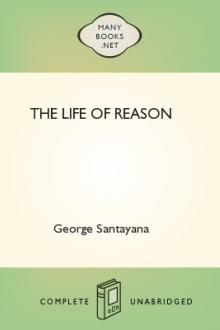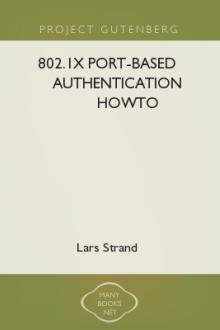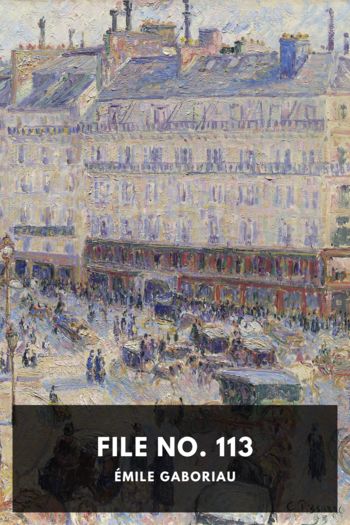The Life of Reason, George Santayana [e novels to read .txt] 📗

- Author: George Santayana
- Performer: -
Book online «The Life of Reason, George Santayana [e novels to read .txt] 📗». Author George Santayana
Of the two approaches which barbaric architecture makes to beauty—one through ornamentation and the other through mass—the latter is in general the more successful. An engineer fights with nature hand to hand: he is less easily extravagant than a decorator; he can hardly ever afford to be absurd. He becomes accordingly more rapidly civilised and his work acquires, in spite of itself, more rationality and a more permanent charm. A self-sustaining structure, in art as in life, is the only possible basis for a vital ideal. When the framework is determined, when it is tested by trial and found to stand and serve, it will gradually ingratiate itself with the observer; affinities it may have in his memory or apperceptive habits will come to light; they will help him to assimilate the new vision and will define its æsthetic character. Whatever beauty its lines may have will become a permanent possession and whatever beauties they exclude will be rejected by a faithful artist, no matter how sorely at first they may tempt him. Not that these excluded beauties would not be really beautiful; like fashions, they would truly please in their day and very likely would contain certain absolute excellences of form or feeling which an attentive eye could enjoy at any time. Yet if appended to a structure they have no function in, these excellences will hardly impose themselves on the next builder. Being adventitious they will remain optional, and since fancy is quick, and exotic beauties are many, there will be no end to the variations, in endless directions, which art will undergo. Caprice will follow caprice and no style will be developed.
A settled style is perhaps in itself no desideratum. A city that should be a bazaar of all possible architectures, adding a multitude of new inventions to samples of every historical style, might have a certain interest; yet carnival can hardly be enjoyed all the year round and there is a certain latent hideousness in masquerades in spite of their glitter. Not only are the effects juxtaposed incongruous, but each apart is usually shallow and absurd. A perruque cannot bring back courtly manners, and a style of architecture, when revived, is never quite genuine; adaptations have to be introduced and every adaptation, the bolder it is, runs the greater risk of being extravagant. Nothing is more pitiable than the attempts people make, who think they have an exquisite sensibility, to live in a house all of one period. The connoisseur, like an uncritical philosopher, boasts to have patched his dwelling perfectly together, but he has forgotten himself, its egregious inhabitant. Nor is he merely a blot in his own composition; his presence secretly infects and denaturalises everything in it. Ridiculous himself in such a setting, he makes it ridiculous too by his æsthetic pose and appreciations; for the objects he has collected or reproduced were once used and prized in all honesty, when life and inevitable tradition had brought them forth, while now they are studied and exhibited, relics of a dead past and evidences of a dead present. Historic remains and restorations might well be used as one uses historic knowledge, to serve some living interest and equip the mind for the undertakings of the hour. An artist may visit a museum but only a pedant can live there. Ideas that have long been used may be used still, if they remain ideas and have not been congealed into memories. Incorporated into a design that calls for them, traditional forms cease to be incongruous, as words that still have a felt meaning may be old without being obsolete. All depends on men subserving an actual ideal and having so firm and genuine an appreciation of the past as to distinguish at once what is still serviceable in it from what is already ghostly and dead.
An artist may be kept true to his style either by ignorance of all others or by love of his own. This fidelity is a condition of progress. When he has learned to appreciate whatever is æsthetically appreciable in his problem, he can go on to refine his construction, to ennoble, and finally to decorate it. As fish, flesh, and fowl have specific forms, each more or less beautiful and adorned, so every necessary structure has its specific character and its essential associations. Taking his cue from these, an artist may experiment freely; he may emphasise the structure in the classic manner and turn its lines into ornament, adding only what may help to complete and unite its suggestions. This puritanism in design is rightly commended, but its opposite may be admirable too. We may admit that nudity is the right garment for the gods, but it would hardly serve the interests of beauty to legislate that all mortals should always go naked. The veil that conceals natural imperfections may have a perfection of its own. Maxims in art are pernicious; beauty is here the only commandment. And beauty is a free natural gift. When it has appeared, we may perceive that its influence is rational, since it both expresses and fosters a harmony of impressions and impulses in the soul; but to take any mechanism whatever, and merely because it is actual or necessary to insist that it is worth exhibiting, and that by divine decree it shall be pronounced beautiful, is to be quite at sea in moral philosophy.
Beauty is adventitious, occasional, incidental, in human products no less than in nature. Works of art are automatic figments which nature fashions through man. It is impossible they should be wholly beautiful, as it is impossible that they should offer no foothold or seed-plot for beauty at all. Beauty is everywhere potential and in a way pervasive because existence itself presupposes a modicum of harmony, first within the thing and then between the thing and its environment. Of this environment the observer's senses are in this case an important part. Man can with difficulty maintain senses quite out of key with the stimuli furnished by the outer world. They would then be useless burdens to his organism. On the other side, even artificial structures must be somehow geometrical or proportional, because only such structures hold physically together. Objects that are to be esteemed by man must further possess or acquire some function in his economy; otherwise they would not be noticed nor be so defined as to be recognisable. Out of these physical necessities beauty may grow; but an adjustment must first take place between the material stimulus and the sense it affects. Beauty is something spiritual and, being such, it rests not on the material constitution of each existence taken apart, but on their conspiring ideally together, so that each furthers the other's endeavour. Structure by itself is no more beautiful than existence by itself is good. They are only potentialities or conditions of excellence.
An architect, when his main structure is uninteresting, may have recourse to a subsidiary construction. The façade, or a part of it, or the interior may still have a natural form that lends itself to elaboration. This beautiful feature may be developed so as to ignore or even conceal the rest; then the visible portion may be entirely beautiful, like the ideal human figure, though no pledges be given concerning the anatomy within. Many an Italian palace has a false front in itself magnificent. We may chance to observe, however, that it overtops its backing, perhaps an amorphous rambling pile in quite another material. What we admire is not so much a façade as a triumphal gateway, set up in front of the house to be its ambassador to the world, wearing decidedly richer apparel than its master can afford at home. This was not vanity in the Italians so much as civility to the public, to whose taste this flattering embassy was addressed. However our moral sense may judge the matter, it is clear that two separate monuments occupied the architect in such cases, if indeed inside and outside were actually designed by the same hand. Structure may appear in each independently and may be frankly enough expressed. The most beautiful façades, even if independent of their building, are buildings themselves, and since their construction is decorative there is the greater likelihood that their decoration should be structural.
In relation to the house, however, the façade in such an extreme case would be an abstract ornament; and so, though the ornament be structural within its own lines, we have reverted to the style of building where construction is one thing and decoration another. Applied ornament has an indefinite range and there would be little profit in reasoning about it. Philosophy can do little more at this point than expose the fallacies into which dogmatic criticism is apt to fall. Everything is true decoration which truly adorns, and everything adorns which enriches the impression and pleasantly entertains the eye. There is a decorative impulse as well as a sense for decoration. As I sit idle my stick makes meaningless marks upon the sand; or (what is nearer to the usual origin of ornament) I make a design out of somebody's initials, or symbolise fantastically something lying in my thoughts. We place also one thing upon another, the better to see and to think of two things at once.
To love decoration is to enjoy synthesis: in other words, it is to have hungry senses and unused powers of attention. This hunger, when it cannot well be fed by recollecting things past, relishes a profusion of things simultaneous. Nothing is so much respected by unintelligent people as elaboration and complexity. They are simply dazed and overawed at seeing at once so much more than they can master. To overwhelm the senses is, for them, the only way of filling the mind. It takes cultivation to appreciate in art, as in philosophy, the consummate value of what is simple and finite, because it has found its pure function and ultimate import in the world. What is just, what is delicately and silently adjusted to its special office, and thereby in truth to all ultimate issues, seems to the vulgar something obvious and poor. What astonishes them is the crude and paradoxical jumble of a thousand suggestions in a single view. As the mystic yearns for an infinitely glutted consciousness that feels everything at once and is not put to the inconvenience of any longer thinking or imagining, so the barbarian craves the assault of a myriad sensations together, and feels replete and comfortable when a sort of infinite is poured into him without ideal mediation. As ideal mediation is another name for intelligence, so it is the condition of elegance. Intelligence and elegance naturally exist together, since they both spring from a subtle sense for absent and eventual processes. They are sustained by experience, by nicety in foretaste and selection. Before ideality, however, is developed, volume and variety must be given bodily or they cannot be given at all. At that earlier stage a furious ornamentation is the chief vehicle for beauty.
That the ornate may be very beautiful, that in fact what is to be completely beautiful needs to be somehow rich, is a fact of experience which further justifies the above analysis. For sensation is the matter of ideas; all representation is such only in its function; in its existence it remains mere feeling. Decoration, by stimulating the senses, not only brings a primary satisfaction with it, independent of any that may supervene, but it furnishes an element of effect which no higher beauty can ever render unwelcome or inappropriate, since any higher beauty, in moving





Comments (0)